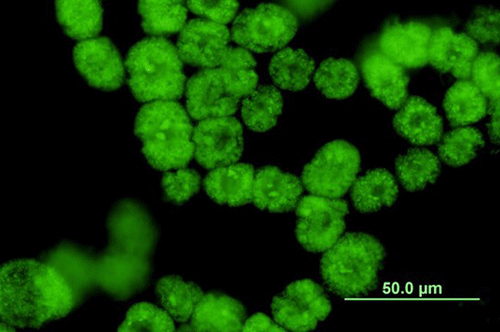New science platforms at IROs
Gymnodinium catenatum: a bloom-forming species of microalgae found in NZ waters. Image: Cawthron Institute.
New six-year strategic science platforms have been established at the Cawthron Institute to support research to improve the performance of New Zealand's seafood safety and shellfish aquaculture, and at the Leather and Shoe Research Association (LASRA) to support hide and skin processing industries. These science platforms are part of the Strategic Science Investment Fund (SSIF), supporting programmes and infrastructure of enduring importance to
Cawthron will host two platforms for six years. It will investigate seafood safety with the aim of managing all harvest risks for
Seafood Safety
The Seafood Safety Platform builds on over 15 years of R&D led by Cawthron in partnership with AgResearch, Plant and Food Research, and the
This proactive platform safeguards
The programme assures industry of continued access to preferred international markets through management of pre- and post-harvest risks.
Threats to seafood quality and safety from harmful algal blooms (HABs) will be managed through the implementation of research that seeks to:
- understand biological and hydrodynamic factors that drive HAB events;
- advance molecular technologies to enhance detection, species identification and enumeration;
- determine impacts of climate change on seafood safety; and
- improve marine toxin analysis and toxicity assessment to ensure appropriate monitoring and regulation.
Threats to seafood quality and safety from pathogenic bacteria and viruses will be managed through research to:
- understand bacterial contamination in growing waters;
- minimize post-harvest bacterial contamination;
- enhance virus monitoring and improve understanding of infectivity; and
- develop new / modernized tools for microbial discrimination and source tracking.
Emerging and future threats will be managed by proactively identifying and assessing the risks posed.
Platform scientists represent
The Seafood Safety Platform is a critical asset to
Shellfish aquaculture
Aquaculture is the world's fastest growing primary sector and is identified by the Government and industry as a significant growth opportunity for
Cawthron's Shellfish Aquaculture Platform will help industry push beyond this target, by:
- enabling the sustainable growth of New Zealand's existing shellfish aquaculture industry through innovation along the value chain including reliable seed supply, improved genetics, precision farming methods and new products;
- enabling new and emerging shellfish aquaculture industry including geoduck, flat oyster, and a pipeline of future species opportunities; and
- securing shellfish aquaculture production with improved shellfish health management, disease risk mitigation, and biofouling management.
These goals will be achieved by continuing Cawthron’s ground-breaking work on domesticating New Zealand’s valuable shellfish species. This revolution will provide a reliable seed supply and enable selective breeding of these stocks, yielding higher productivity, quality, and market value. Where technical barriers hinder farming, Cawthron partners with industry to develop solutions. Securing these gains, new tools will manage the risk to aquaculture from threats and position the sector to react more effectively to future problems.
The Shellfish Aquaculture Platform is the hub of
Export quality hides
The Export Quality Hides Platform aims to grow and secure
To meet these rising expectations and demands, platform research focuses on improvements in quality, environmental sustainability, and performance to increase
More specifically the platform will:
- develop processes for leather manufacture which require less reagents and minimise discharge of waste. Alternative reagents and processes will be identified to reduce the environmental impact of leather processing;
- analyse genetic markers for meat quality and other traits to quantify their effect on pelt quality; and
- develop remote sensing technologies that allow features that affect quality to be quantified in real time.
A traceability system will be developed to identify the origin of
Through improvements in the value of the meat industry’s most valuable co-product, the platform works to support and develop benefits across the entire farm system by establishing the position of leather as an important component in the future of farming, and minimising its contribution to the total carbon footprint.
Date posted: 30 July 2018

